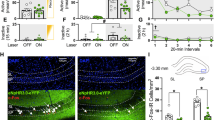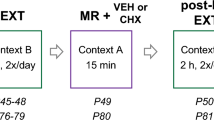Abstract
It is widely held that long-term memories are established by consolidation of newly acquired information into stable neural representations, a process that requires protein synthesis and synaptic plasticity. Plasticity within the nucleus accumbens (NAc), a major component of the ventral striatum, is thought to mediate instrumental learning processes and many aspects of drug addiction. Here we show that the inhibition of protein synthesis within the NAc disrupts consolidation of an appetitive instrumental learning task (lever-pressing for food) in rats. Post-trial infusions of anisomycin immediately after the first several training sessions prevented consolidation, whereas infusions delayed by 2 or 4 hours had no effect. However, if the rats were allowed to learn the task, the behavior was not sensitive to disruption by intra-accumbens anisomycin. Control infusions into the medial NAc shell or the dorsolateral striatum did not impair learning; in fact, an enhancement was observed in the latter case. These results show that de novo protein synthesis within the NAc is necessary for the consolidation, but not reconsolidation, of appetitive instrumental memories.
This is a preview of subscription content, access via your institution
Access options
Subscribe to this journal
Receive 12 print issues and online access
$209.00 per year
only $17.42 per issue
Buy this article
- Purchase on Springer Link
- Instant access to full article PDF
Prices may be subject to local taxes which are calculated during checkout




Similar content being viewed by others
References
Thorndike, E. Animal Intelligence (Macmillan, New York, 1911).
Skinner, B.F. Science and Human Behavior (Macmillan, New York, 1953).
Rescorla, R.A. Associative relations in instrumental learning: the eighteenth Bartlett memorial lecture. Q. J. Exp. Psychol. B 43, 1–23 (1991).
Dickinson, A. & Balleine, B. Motivational control of goal-directed action. Anim. Learn. Behav. 22, 1–18 (1994).
Abel, T. & Lattal, K.M. Molecular mechanisms of memory acquisition, consolidation and retrieval. Curr. Opin. Neurobiol. 11, 180–187 (2001).
Mishkin, M. & Petri, H.L. in Neuropsychology of Memory (eds. Butters, N. & Squire, L. R.) 287–296 (Guilford, New York, 1984).
Nader, K., Schafe, G.E. & LeDoux, J.E. The labile nature of consolidation theory. Nat. Rev. Neurosci. 1, 216–219 (2000).
Dudai, Y. Consolidation: fragility on the road to the engram. Neuron 17, 367–370 (1996).
McGaugh, J.L. Memory—a century of consolidation. Science 287, 248–251 (2000).
Flexner, L.B., Flexner, J.B. & Stellar, E. Memory and cerebral protein synthesis in mice as affected by graded amoutns of puromycin. Exp. Neurol. 13, 264–272 (1965).
Davis, H.P. & Squire, L.R. Protein synthesis and memory: a review. Psychol. Bull. 96, 518–559 (1984).
Agranoff, B.W. Memory and protein synthesis. Sci. Am. 216, 115–122 (1967).
Flood, J.F., Rosenzweig, M.R., Bennett, E.L. & Orme, A.E. The influence of duration of protein synthesis inhibition on memory. Physiol. Behav. 10, 555–562 (1973).
Nader, K., Schafe, G.E. & Le Doux, J.E. Fear memories require protein synthesis in the amygdala for reconsolidation after retrieval. Nature 406, 722–726 (2000).
Berman, D.E. & Dudai, Y. Memory extinction, learning anew, and learning the new: dissociations in the molecular machinery of learning in cortex. Science 291, 2417–2419 (2001).
Mogenson, G.J., Jones, D.L. & Yim, C.Y. From motivation to action: functional interface between the limbic system and the motor system. Prog. Neurobiol. 14, 69–97 (1980).
Smith-Roe, S.L. & Kelley, A.E. Coincident activation of NMDA and dopamine D1 receptors within the nucleus accumbens core is required for appetitive instrumental learning. J. Neurosci. 20, 7737–7742 (2000).
Kelley, A.E., Smith-Roe, S.L. & Holahan, M.R. Response-reinforcement learning is dependent on N-methyl-D-aspartate receptor activation in the nucleus accumbens core. Proc. Natl. Acad. Sci. USA 94, 12174–12179 (1997).
Zahm, D.S. An integrative neuroanatomical perspective on some subcortical substrates of adaptive responding with emphasis on the nucleus accumbens. Neurosci. Biobehav. Rev. 24, 85–105 (2000).
Kelley, A.E., Domesick, V.B. & Nauta, W.J.H. The amygdalostriatal projection in the rat: an anatomical study by anterograde and retrograde tracing methods. Neuroscience 7, 615–630 (1982).
Marshall, J.F., Berrios, N. & Sawyer, S. Neostriatal dopamine and sensory inattention. J. Comp. Physiol. Psychol. 94, 833–846 (1980).
Kandel, E.R. The molecular biology of memory storage: a dialogue between genes and synapses. Science 294, 1030–1038 (2001).
Vianna, M.R., Szapiro, G., McGaugh, J.L., Medina, J.H. & Izquierdo, I. Retrieval of memory for fear-motivated training initiates extinction requiring protein synthesis in the rat hippocampus. Proc. Natl. Acad. Sci. USA 98, 12251–12254 (2001).
Lattal, K.M. & Abel, T. Different requirements for protein synthesis in acquisition and extinction of spatial preferences and context-evoked fear. J. Neurosci. 21, 5773–5780 (2001).
Gurden, H., Takita, M. & Jay, T.M. Essential role of D1 but not D2 receptors in the NMDA receptor-dependent long-term potentiation at hippocampal-prefrontal cortex synapses in vivo. J. Neurosci. 20, RC106 (2000).
Wang, J. & O'Donnell, P. D(1) dopamine receptors potentiate nmda-mediated excitability increase in layer V prefrontal cortical pyramidal neurons. Cereb. Cortex 11, 452–462 (2001).
Baldwin, A.E., Holahan, M.R., Sadeghian, K. & Kelley, A.E. N-methy-D-aspartate receptor-dependent plasticity within a distributed corticostriatal network mediates appetitive instrumental learning. Behav. Neurosci. 114, 1–15 (2000).
Meiri, N. & Rosenblum, K. Lateral ventricle injection of the protein synthesis inhibitor anisomycin impairs long-term memory in a spatial memory task. Brain Res. 789, 48–55 (1998).
Bracha, V. et al. Microinjections of anisomycin into the intermediate cerebellum during learning affect the acquisition of classically conditioned responses in the rabbit. Brain Res. 788, 169–178 (1998).
Springer, A.D. & Agranoff, B.W. Puromycin-induced retention deficit in goldfish as a function of attained training performance level. Behav. Biol. 17, 547–554 (1976).
Scharf, M.T. et al. Protein synthesis is required for the enhancement of long-term potentiation and long-term memory by spaced training. J. Neurophysiol. 87, 2770–2777 (2002).
Fairley, P.C. & Marshall, J.F. Dopamine in the lateral caudate-putamen of the rat is essential for somatosensory orientation. Behav. Neurosci. 100, 652–663 (1986).
Carli, M., Evenden, J.L. & Robbins, T.W. Depletion of unilateral striatal dopamine impairs initiation of contralateral actions and not sensory attention. Nature 313, 679–682 (1985).
Crofts, H.S. et al. Differential effects of 6-OHDA lesions of the frontal cortex and caudate nucleus on the ability to acquire an attentional set. Cereb. Cortex 11, 1015–1026 (2001).
Haber, S.N., Fudge, J.L. & McFarland, N.R. Striatonigrostriatal pathways in primates form an ascending spiral from the shell to the dorsolateral striatum. J. Neurosci. 20, 2369–2382 (2000).
Parkinson, J.A., Cardinal, R.N. & Everitt, B.J. Limbic cortical-ventral striatal systems underlying appetitive conditioning. Prog. Brain Res. 126, 263–285 (2000).
Corbit, L.H., Muir, J.L. & Balleine, B.W. The role of the nucleus accumbens in instrumental conditioning: evidence of a functional dissociation between accumbens core and shell. J. Neurosci. 21, 3251–3260 (2001).
Hyman, S.E. & Malenka, R.C. Addiction and the brain: the neurobiology of compulsion and its persistence. Nat. Rev. Neurosci. 2, 695–703 (2001).
Rosenblum, K., Meiri, N. & Dudai, Y. Taste memory: the role of protein synthesis in gustatory cortex. Behav. Neural Biol. 59, 49–56 (1993).
Paxinos, G. & Watson, C.W. The Rat Brain in Stereotaxic Coordinates (Academic, San Diego, 1998).
Acknowledgements
This work was supported by grant DA04788 from the National Institute on Drug Abuse. P.J.H. is supported by grant GM07507 from the National Institute of General Medical Sciences.
Author information
Authors and Affiliations
Corresponding author
Ethics declarations
Competing interests
The authors declare no competing financial interests.
Rights and permissions
About this article
Cite this article
Hernandez, P., Sadeghian, K. & Kelley, A. Early consolidation of instrumental learning requires protein synthesis in the nucleus accumbens. Nat Neurosci 5, 1327–1331 (2002). https://doi.org/10.1038/nn973
Received:
Accepted:
Published:
Issue Date:
DOI: https://doi.org/10.1038/nn973
This article is cited by
-
Opposing roles for striatonigral and striatopallidal neurons in dorsolateral striatum in consolidating new instrumental actions
Nature Communications (2021)
-
Molecular Plasticity of the Nucleus Accumbens Revisited—Astrocytic Waves Shall Rise
Molecular Neurobiology (2019)
-
The details of past actions on a smartphone touchscreen are reflected by intrinsic sensorimotor dynamics
npj Digital Medicine (2018)
-
Global and local excitation and inhibition shape the dynamics of the cortico-striatal-thalamo-cortical pathway
Scientific Reports (2017)
-
Functional states of rat cortical circuits during the unpredictable availability of a reward-related cue
Scientific Reports (2016)



